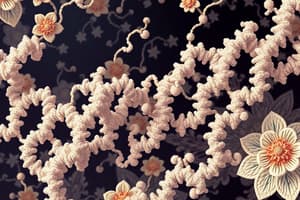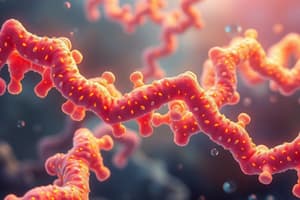Podcast
Questions and Answers
What is the effect of acetylation on lysine residues in histone proteins?
What is the effect of acetylation on lysine residues in histone proteins?
- It promotes the synthesis of proproteins.
- It enhances the binding affinity of DNA to histones.
- It neutralizes the positive charge of lysine. (correct)
- It increases the positive charge of lysine.
Which amino acids can undergo lipidation as a post-translational modification?
Which amino acids can undergo lipidation as a post-translational modification?
- Only lysine.
- Aromatic amino acids only.
- Lysine, cysteine, and serine. (correct)
- All amino acids.
What is the role of proteolysis in protein activity?
What is the role of proteolysis in protein activity?
- It modifies the DNA structure.
- It synthesizes proteins in their active form.
- It cleaves proproteins to activate them. (correct)
- It enhances the binding of cofactors.
What is the distinction between cofactors and coenzymes?
What is the distinction between cofactors and coenzymes?
What characterizes tightly bound cofactors in proteins?
What characterizes tightly bound cofactors in proteins?
What term describes the most common amino acid sequence found in the wild for a given protein?
What term describes the most common amino acid sequence found in the wild for a given protein?
How is a protein substitution mutation typically indicated?
How is a protein substitution mutation typically indicated?
Which mutation is likely to have a smaller effect on protein function?
Which mutation is likely to have a smaller effect on protein function?
What type of mutation changes an amino acid to one with different chemical properties?
What type of mutation changes an amino acid to one with different chemical properties?
Which of the following best describes a mutation that maintains the same chemical properties?
Which of the following best describes a mutation that maintains the same chemical properties?
What impact does the location of a mutation within a protein have?
What impact does the location of a mutation within a protein have?
In the designation Q37L, what does '37' indicate?
In the designation Q37L, what does '37' indicate?
Which of the following mutations is indicated as being less impactful on function?
Which of the following mutations is indicated as being less impactful on function?
In which regions are nonconservative mutations less likely to significantly affect protein function?
In which regions are nonconservative mutations less likely to significantly affect protein function?
What describes amino acids that must remain unaltered for proper protein function?
What describes amino acids that must remain unaltered for proper protein function?
What type of mutation is likely to be significant in highly structured regions?
What type of mutation is likely to be significant in highly structured regions?
Which type of enzyme facilitates the phosphorylation of proteins?
Which type of enzyme facilitates the phosphorylation of proteins?
If amino acids at certain positions can vary without impacting function, how are they described?
If amino acids at certain positions can vary without impacting function, how are they described?
What happens to a protein during post-translational modifications?
What happens to a protein during post-translational modifications?
What is the significance of comparing wild-type sequences of a protein across species?
What is the significance of comparing wild-type sequences of a protein across species?
What characterizes amino acids that vary significantly across species?
What characterizes amino acids that vary significantly across species?
Which of the following residues is NOT typically involved in phosphorylation?
Which of the following residues is NOT typically involved in phosphorylation?
What is the main impact of a conservative mutation in a protein's critical region?
What is the main impact of a conservative mutation in a protein's critical region?
What is the primary role of glycosylation of proteins as they move from the ER to the Golgi?
What is the primary role of glycosylation of proteins as they move from the ER to the Golgi?
Which amino acid residues are primarily modified by O-linked glycosylation?
Which amino acid residues are primarily modified by O-linked glycosylation?
What distinguishes ubiquitination from other post-translational modifications?
What distinguishes ubiquitination from other post-translational modifications?
Which type of bond is formed during ubiquitination between ubiquitin and a target protein?
Which type of bond is formed during ubiquitination between ubiquitin and a target protein?
What activates the proteasome to degrade proteins marked for destruction?
What activates the proteasome to degrade proteins marked for destruction?
During the acetylation process, which part of lysine acts as the nucleophile?
During the acetylation process, which part of lysine acts as the nucleophile?
What happens to cytosolic proteins that are misfolded as part of the ubiquitination process?
What happens to cytosolic proteins that are misfolded as part of the ubiquitination process?
What is the outcome of adding multiple ubiquitin molecules to a target protein?
What is the outcome of adding multiple ubiquitin molecules to a target protein?
What is the primary biochemical process that acetylation of lysine residues is involved in?
What is the primary biochemical process that acetylation of lysine residues is involved in?
What type of reaction converts lysine to acetylated lysine?
What type of reaction converts lysine to acetylated lysine?
What is the primary role of phosphorylation in protein function?
What is the primary role of phosphorylation in protein function?
Which amino acids have a hydroxyl group that can act as a nucleophile for ATP?
Which amino acids have a hydroxyl group that can act as a nucleophile for ATP?
What happens when a serine or threonine residue is mutated to aspartate?
What happens when a serine or threonine residue is mutated to aspartate?
Where does glycosylation most commonly occur?
Where does glycosylation most commonly occur?
What distinguishes N-linked glycosylation from O-linked glycosylation?
What distinguishes N-linked glycosylation from O-linked glycosylation?
Which type of enzyme facilitates the process of glycosylation?
Which type of enzyme facilitates the process of glycosylation?
What is the impact of adding a phosphate group to a protein?
What is the impact of adding a phosphate group to a protein?
Why can mutation to aspartate sometimes lead to a protein being constitutively active?
Why can mutation to aspartate sometimes lead to a protein being constitutively active?
Which of the following is a common consequence of protein phosphorylation?
Which of the following is a common consequence of protein phosphorylation?
Why is it less common for other amino acid side chains to undergo phosphorylation?
Why is it less common for other amino acid side chains to undergo phosphorylation?
Flashcards
Protein Mutations
Protein Mutations
Changes in the amino acid sequence of a protein due to alterations in the corresponding gene.
Wild-type Protein
Wild-type Protein
The most common amino acid sequence of a protein found in nature.
Mutant Protein
Mutant Protein
A version of a protein with an amino acid sequence different from the wild-type.
Protein Mutation Notation
Protein Mutation Notation
Signup and view all the flashcards
Conservative Mutation
Conservative Mutation
Signup and view all the flashcards
Nonconservative Mutation
Nonconservative Mutation
Signup and view all the flashcards
Mutation Location
Mutation Location
Signup and view all the flashcards
Protein Structure and Function
Protein Structure and Function
Signup and view all the flashcards
Mutations in flexible regions
Mutations in flexible regions
Signup and view all the flashcards
Mutations in structured regions
Mutations in structured regions
Signup and view all the flashcards
Critical regions and conservative mutations
Critical regions and conservative mutations
Signup and view all the flashcards
Conserved amino acids
Conserved amino acids
Signup and view all the flashcards
Highly conserved amino acids
Highly conserved amino acids
Signup and view all the flashcards
Less strictly conserved amino acids
Less strictly conserved amino acids
Signup and view all the flashcards
Non-conserved amino acids
Non-conserved amino acids
Signup and view all the flashcards
Translation
Translation
Signup and view all the flashcards
Post-translational modifications
Post-translational modifications
Signup and view all the flashcards
Phosphorylation
Phosphorylation
Signup and view all the flashcards
Acetylation
Acetylation
Signup and view all the flashcards
Lipidation
Lipidation
Signup and view all the flashcards
Proteolysis
Proteolysis
Signup and view all the flashcards
Cofactor
Cofactor
Signup and view all the flashcards
Protein Phosphorylation
Protein Phosphorylation
Signup and view all the flashcards
Kinases
Kinases
Signup and view all the flashcards
Phosphorylation Sites
Phosphorylation Sites
Signup and view all the flashcards
Effect of Phosphorylation
Effect of Phosphorylation
Signup and view all the flashcards
Phosphomimetic Mutation
Phosphomimetic Mutation
Signup and view all the flashcards
Glycosylation
Glycosylation
Signup and view all the flashcards
Glycosyltransferases
Glycosyltransferases
Signup and view all the flashcards
N-linked Glycosylation
N-linked Glycosylation
Signup and view all the flashcards
O-linked Glycosylation
O-linked Glycosylation
Signup and view all the flashcards
Effect of Glycosylation
Effect of Glycosylation
Signup and view all the flashcards
Ubiquitination
Ubiquitination
Signup and view all the flashcards
Isopeptide bond
Isopeptide bond
Signup and view all the flashcards
Polyubiquitin chain
Polyubiquitin chain
Signup and view all the flashcards
Proteasome
Proteasome
Signup and view all the flashcards
Acetyl coenzyme A
Acetyl coenzyme A
Signup and view all the flashcards
N-terminal acetylation
N-terminal acetylation
Signup and view all the flashcards
Study Notes
Protein Modifications
- Proteins are chains of amino acids; their sequence dictates function.
- Protein function can also depend on non-amino acid chemical groups.
- Mutations can alter amino acid sequences, causing variations between species or individuals.
- Wild-type refers to the most common sequence in a species.
- Mutations can be conservative (similar chemical properties) or non-conservative (different chemical properties).
- Mutation location impacts effect: flexible regions less impacted; critical regions more impacted.
- Conservation of amino acids in related proteins shows critical positions for structure and function.
Post-translational Modifications
- Proteins can be modified after translation by enzymes adding non-amino acid groups.
- Phosphorylation: Adding a phosphate group (from ATP) to a protein; often regulates activity.
- Glycosylation: Adding carbohydrate groups; involved in protein targeting and folding.
- Ubiquitination: Adding ubiquitin to a protein; typically targets the protein for degradation.
- Acetylation: Adding an acetyl group; often involved in regulating gene expression (histone modification).
- Lipidation: Adding a lipid group; often involved in membrane or signaling processes.
Cofactors
- Cofactors are non-amino acid groups needed for protein function.
- Coenzymes are organic cofactors that often assist enzymes.
- Prosthetic groups are tightly bound cofactors that are effectively part of the enzyme.
- Heme is a cofactor crucial for some protein functions involved in oxygen transport and storage.
- Apoproteins lack cofactors, while holoproteins have them. Only holoproteins function correctly.
- Proteolysis: Removing groups from proteins via protease enzyme hydrolysis.
Studying That Suits You
Use AI to generate personalized quizzes and flashcards to suit your learning preferences.




